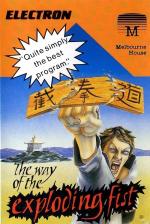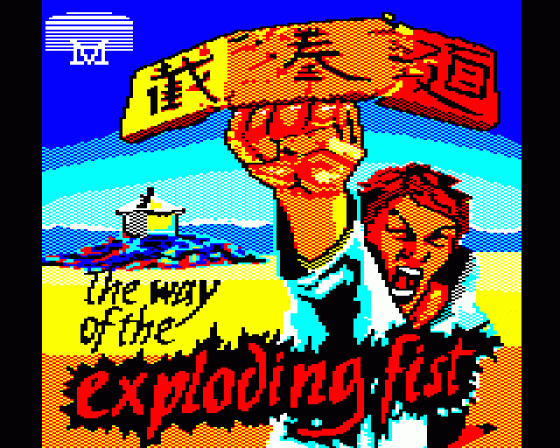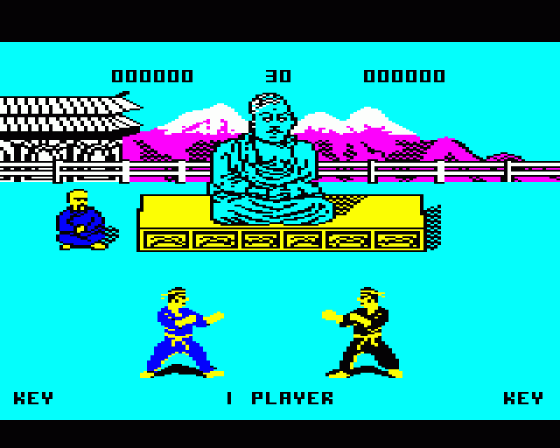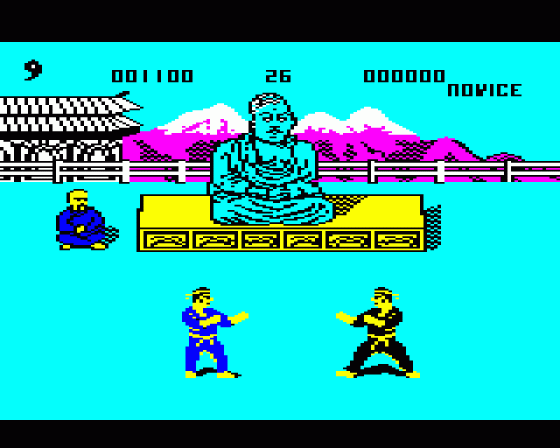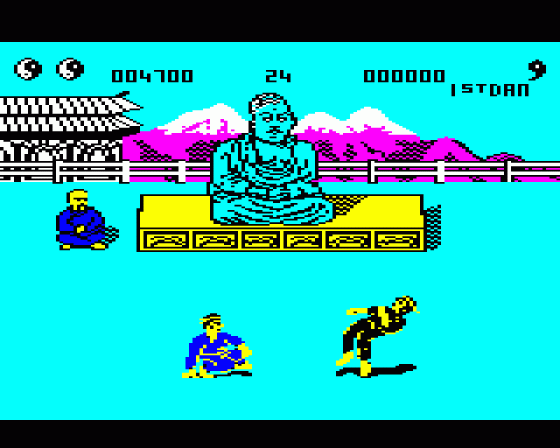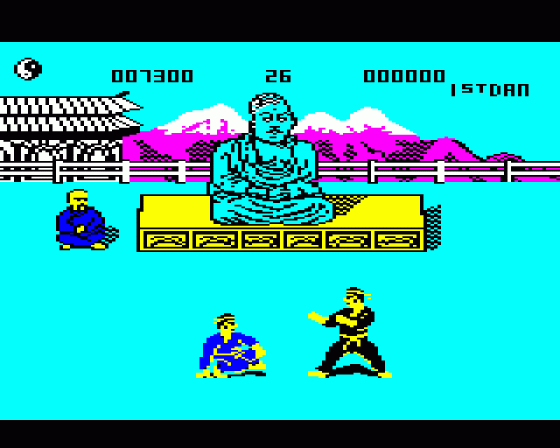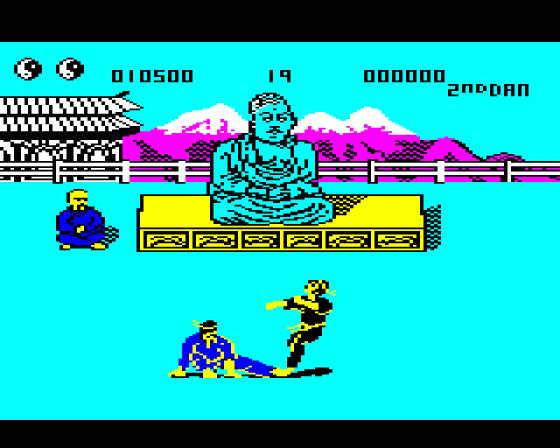
Everygamegoing
 26th August 2018
26th August 2018
Author: Dave E
Publisher: Melbourne House
Machine: Acorn Electron
Published in EGG #013: Acorn Electron
The Way Of The Exploding Fist
If there's one thing that's in short supply on the Electron, it's two player games. We all know it's very satisfying to shoot your friend in the back or, in the case of Way Of The Exploding Fist, perform a roundhouse kick to his face. It's much more satisfying than facing off against a computerised opponent anyway. Fist was universally adored back in the Eighties, because it offered you the best of both worlds. First, an opportunity to learn how to kick and punch an opponent into oblivion alone. And second, an opportunity to put those skills to good use upon that real life kid whose dad had bought him a shiny new Spectrum with a lightgun for Christmas (whilst you contented yourself with yet another Repton game). For example.
Fist is a game that hangs together so well that it's difficult to single out one element for particular praise over and above any other. Visually, however, it's certainly a very striking game. The two karate fighters are very impressively animated, the graphics looking as if real life combatants were hand-drawn and a lot of care then taken to ensure they flowed from one position to another. The imposing Buddha is quite appealing too.
If you're playing the one-player version of the game, the objective is to beat each of the opponents. There are eleven in total, beginning with a novice and culminating in the "10th Dan". The first three or so can be beaten fairly easily. Indeed, one move - the forward sweep - is particularly effective. However, at 3rd Dan, things get tougher, and it's time to start using pacing, distance and unexpected combos to finally deliver that knockout blow. You play the blue karate fighter and the computer takes the black one.
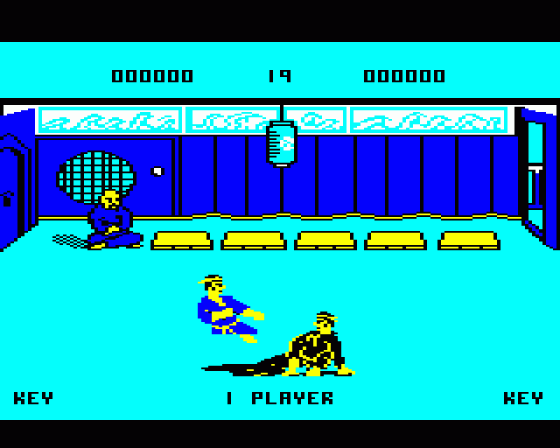
Each time you manage to hit your opponent, he will collapse and you will be awarded either a full point or a half point. This system is a little confusing at first but is essentially how "well" you executed the fighting move, combined with whether you managed to make contact with your opponent using a particularly "sophisticated" move, or you just jabbed him in the stomach. Obviously, executing clean, sophisticated moves will power through the early opponents more quickly.
You need to get at least two points to defeat your opponent and each bout is timed to the tune of thirty seconds. If the time runs out, the fighter with the most points is declared the winner. There is a rather humble bow of the head to acknowledge this.
There are approximately sixteen moves in total and then are pulled off by using a hollow "square" of keys, and a Fire button. The key chosen as Fire is actually Escape, an odd choice that means you require both hands for keyboard play (playing with a joystick only requires one). As you might expect, left and right do the obvious, whilst up and down will jump and crouch respectively.
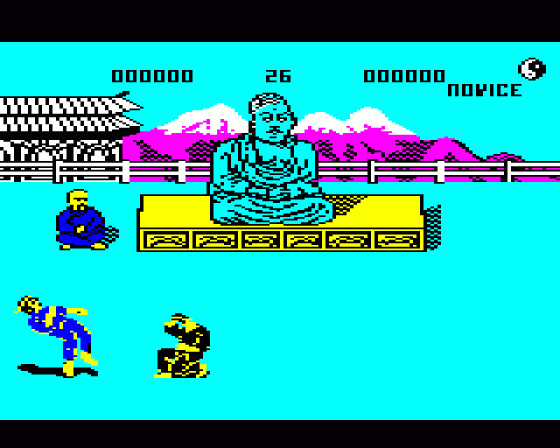
In many fighting games, you find that holding the Fire button and moving the joystick in "combo" moves is the key to victory. However, in Fist, you'll find that two of the standard aggressive moves don't require the fire button at all. High punch and jab are pulled off by simply pressing up/down and right together. Pressing either up or down in combination with left produces a smooth somersault which covers a lot of ground very quickly, so if you feel like your opponent is about to execute a move to take you down, this is a very good way of putting the necessary space between the pair of you.
In regard to scrapping itself, it's otherwise achieved by using one of the eight control keys in combination with Fire. The variety of moves you can execute was fantastic for its day and the gameplay still holds up pretty well now. The small number of moves are easy to remember and you reach for them instinctively during a bout, making you feel really "at one" with the game itself.
As music on the Electron is so rare an occurrence, it's also worth pointing out that Fist plays a background tune throughout all the action... although I can't quite decide if that's a good or a bad thing. It's a fairly simplistic jingle rather than something accomplished, and I actually prefer to turn it off. With all the splendid graphics, I'm actually surprised that there was any memory left over for this little bonus...!
As you might imagine, Fist is hands down the best karate simulation on the Electron and it received so much praise that I'm almost spoilt for choice as far as quotes go. Here are some though. "Of all the games on the market, this has to be the winner" (Electron User). "It's so visually absorbing that I feel it is almost beyond criticism" (A&B). And "This game has everything" (Acorn User). I wholeheartedly agree. The one player game is good. The two player game is even better.
Want a physical version? There are two standalone versions - full price and budget - plus two compilation releases (Five Star Games III & Megaplay 1). For some reason no-one has ever been able to explain, the Megaplay 1 version doesn't feature the Buddha graphic although the game itself is completely identical. Expect to pay around £2 for the standalone versions, £5 for Five Star Games III and £10+ for Megaplay 1 (because it's the hardest to find).

